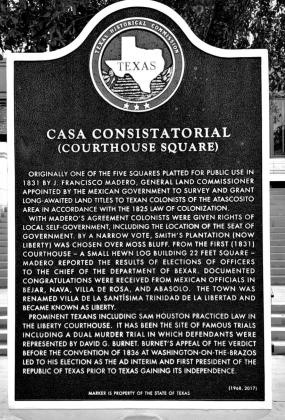CASA CONSISTATORIAL (COURTHOUSE SQUARE)
The site of the current Liberty County Courthouse was originally one of the five (5) squares platted for public use in 1831 by Francisco Madero, General Land Commissioner appointed by the Mexican government to survey and grant long-awaited land titles to Texian Colonists of the Atascosito area in accordance with the 1825 Law of Colonization. Madero agreed colonists should be given rights of local self-government, including the location of the seat of government. An election was held
An election was held and by a narrow vote, Smith’s Plantation (now Liberty) was chosen over Moss Bluff, south of Liberty. From the first (1831) courthouse which was a small hewn log building approximately twenty-two (22’) feet square, Madero reported the results of elections of offices to the chief of the Department of Bexar. Congratulations were received from Mexican officials in Bejar, Nava, Villa DeRosa and Abasolo. The town was renamed Villa de la Santisima Trinidad de la Libertad translated, “Town of the Most Holy Trinity of Liberty.” The town became known simply as Liberty, the English translation of “Libertad.” Liberty was also a town name which many of the early colonists were familiar with in the old Natchez District of Mississippi. Prominent leaders in the Atascosito District had immigrated from that portion of the Natchez District and another “Liberty” which was the county seat of Amite County, Mississippi. Matthew G. White, Hugh B. Johnston, Amos Green, George Orr, William Johnson, William Everett, James McCoy, James Rankins, David Minchey, and others had all come from or once lived in Amite County or nearby. There are indications in early correspondence, as well as Madero’s report of March 30, 1831, the new name of the town had been agreed upon by the colonists and certainly before it was officially named on May 5th, 1831. Madero’s plat of the town of Liberty shows at the center of the inner blocks, Plaza Consistatorial or Courthouse Square, the home of seven (7) courthouses including the current circa 1930 structure.
Prominent Texans, including Sam Houston, practiced law in the Liberty Courthouse. It has been the site of famous trials including a dual murder trial in which defendants were represented by David G. Burnet. His clients were John M. Smith and his son, William M. Smith of Liberty County, who had been indicted for the murder of Alfred Carroll, the husband of John M. Smith’s daughter. The Smiths were not extremely popular in Liberty County as they had sided against the Anglo colonists in their difficulties with the Mexican authorities. The complicate things more, Smith had been dispossessed of the land on which the town of Liberty was located and established by Francisco Madero and his Anglo followers in 1831. John M. Smith had been declared ineligible to receive the league of land on which he resided in 1830, then called “Smith’s Plantation.” When the site was chosen by the colonist-voters as the seat of government in 1831, Smith had to leave. There was a lot of community hostility against Smith due to his animosity and opposition to the Texian colonists and general trouble making in this newly settled area. The jury pool, all local citizens and Judge William Hardin, no friends of the Smiths, sent down a “death sentence.” Burnet’s appeal of the verdict before the Convention of 1836 at Washington-On-The-Brazos led to his election as the ad interim and first President of the Republic of Texas prior to Texas gaining its independence. Thus began a long history of sensational trials on this site, the center of Liberty history.
Text revised in 2017.

